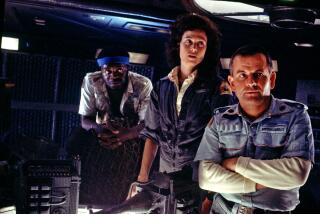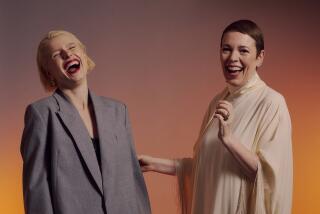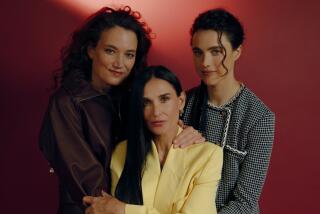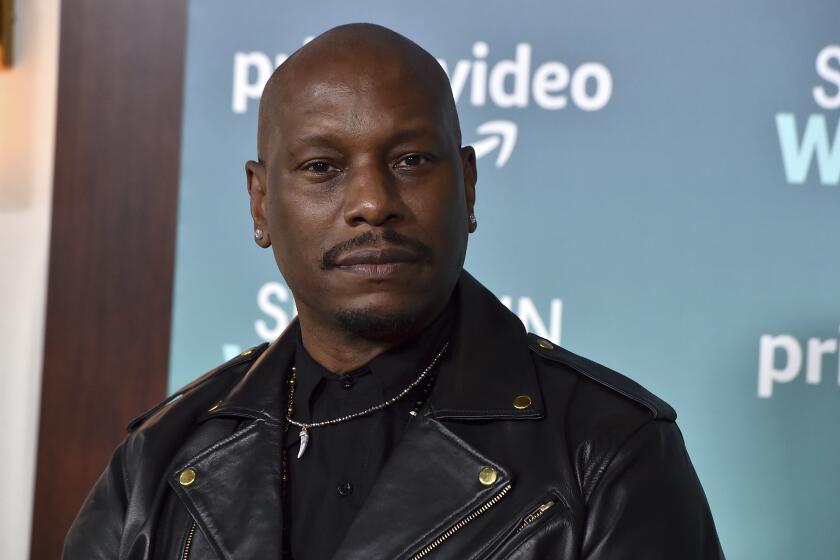DOUBLE FEATURE
New York
Mention personal style and Wes Anderson, who was chortling just a moment ago, looks like he suddenly slurped down a bad oyster. “I don’t want anyone to think I follow trends and fashion because, well, frankly. . . I just don’t,” says the director.
Never mind the fact that Anderson is kitted out in a handmade khaki suit, marlin blue oxford with starched collar and cocoa-brown suede loafers that bear nary a scuff. Or that he popularized the shrunken suit to such a degree that almost every menswear designer -- from Thom Browne to Valentino -- now uses less fabric. Or that his films -- “Rushmore,” “The Royal Tenenbaums,” “The Life Aquatic” -- actually get flak for being so obsessed with style.
Call him a misfit. Call him an outsider. Just don’t call him stylish.
“Wes is very stylish,” says Marc Jacobs by phone from Paris. The designer, as artistic director of Louis Vuitton, teamed with Anderson to come up with a new look -- flannel suits that don’t cinch at the shoulders or reveal naked ankles -- and a set of luggage for his latest film, “The Darjeeling Limited.” The pairing makes perfect sense. Jacobs’ fashion shows have an ethereal, cinematic quality, and he even name-checked Bernardo Bertolucci as inspiration for a recent collection. Anderson’s fastidious attention to quirky style details in his films is legendary.
The fashion designer and the film director, both occasional expats who spend months at a time in Paris, first met a few years ago. “I think we were introduced by Sofia Coppola at a birthday party for her brother, Roman,” says Jacobs, who adored “The Royal Tenenbaums” and was impressed before they even shook hands. Anderson simply says: “I would have to drop a lot of names to be exact, so let’s just say that we met through mutual friends in Paris.”
Anderson’s aversion to name-dropping typifies his cool. It’s an indelible type of composure, like invisible ink. But whether you can decode it or not is no matter. The director has a personal style that informs, even embosses, his films, his characters, and his own distinctive look. And over the years, that style has hatched fashion trends as reliably as a swan spawns ugly ducklings.
Take Anderson’s aforementioned shrunken corduroy suits, which we first saw the director wearing back in 2001 and even earlier on the Max Fischer character in “Rushmore.” Two years later, Thom Browne launched a career with suits that looked like they had been hung to dry in a sauna, clearly taking a cue from Anderson. Designer Scott Sternberg of Band of Outsiders might have raided Anderson’s own closet for the label’s preppy geek aesthetic, a look that’s at the forefront of men’s fashion today.
“Somewhere along the line, I said, ‘I think I will wear suits now.’ Why? Maybe to look more like a grown-up,” Anderson says with a shrug, now seated for a lunch of pasta with boar at Bar Pitti in the West Village. (The setting couldn’t be more Anderson-esque: The walls of the bistro are painted a hue of buttercup. “Yellow Submarine” tumbles from a nearby speaker. If only the waiter would stride over in slow motion.)
Anderson briefly alludes to the informal dress code in Los Angeles but stops himself from bad mouthing the flip-flop capital. “And I like that wearing a suit says, ‘I am professional and serious about what I do,’ which may seem old-fashioned.”
Beyond a signature look
Not according to Vanity Fair, which placed him on its best-dressed list in 2005. Understandably, he’s hesitant to further discuss the very look that branded him more as a wunderkid than a wunderkind. Early, almost every article written about Anderson opened with a description of his shrunken suit.
“I don’t really do that anymore. It just becomes a little embarrassing to become known as the guy in the ill-fitting suit,” says Anderson, fluttering his tapered fingers as if to shoo away any whiff of a bad memory. Jacobs can sympathize. He also resents being distilled down to his signature sartorial accents. “I do not want to be defined by big buttons and Peter Pan collars,” Jacobs says. “That’s only part of what I do.”
When asked about his suit arsenal, Anderson shifts and squints. “How many do I own? Um, not a lot,” he murmurs. “I don’t know.”
What is known is that Anderson has been seeing the same New York-based tailor since the beginning: Mr. Ned on Fifth Avenue at 20th Street. There is no sign out front. A tiny elevator tootles up to the fourth floor and opens to a no-frills loft space crammed with floor to ceiling shelves of fabric bolts. Pinstripes, cashmere, tweeds. It’s a veritable sweet shop for a sartorialist.
“When Wes first came to me, nobody was wearing high-cut suits with two buttons,” says his tailor Vahram Mateosian, whose father was the original Mr. Ned. He has made 25 suits for Anderson. “He definitely doesn’t follow trends, and he knows exactly how to translate what he sees in his head into what he wants. I haven’t had any other customer who could do that.” Mateosian tailored all the suits on “Tenenbaums.”
For “Darjeeling,” Anderson tapped Jacobs because of “his huge resource, in addition to his taste and talent. Marc was up for anything, which I liked,” says Anderson, who sketched out some ideas. Jacobs made some adjustments. (Back in 2005, Anderson had visited the Vuitton workshop outside Paris and viewed archival collections of trunks and suitcases. He may feign ignorance of fashion, but he’s certainly conversant in the big names in luxury.) Anderson’s brother Eric provided the illustrated “Little Prince”-like motif of palm trees, rhinos, zebras and other wildlife.
“At first, the drawings were silk-screened, but Marc didn’t like that,” recalls Anderson. “He wanted them embossed, and it made the luggage much better.” Jacobs, who says he is much too busy right now to design costumes for other films, demurs when asked about his participation: “Wes knows exactly what he wants, and his vision is very particular, which makes it quite easy.”
The result is a large set of tawny luggage and a trio of suits with matching back belts and angled cuffs for the three main characters, played by onscreen brothers Owen Wilson, Adrien Brody and Jason Schwartzman. Once again, as in Anderson’s previous films like “Rushmore” and “The Royal Tenenbaums,” the cast wears one look throughout the film. “I like actors to have costumes that help them to get into character,” says Anderson. “Whether it’s a good idea or not, I tend to give them uniforms.”
The Anderson effect
Those uniforms can boost a brand’s popularity too. The custom Adidas sneakers with yellow laces that Bill Murray and his crew wore in “The Life Aquatic With Steve Zissou” in 2004 were so coveted -- and unavailable -- that the website Cool Hunting launched an online petition with 600 names to get the sneaker company to create a special edition. They didn’t.
But it’s the quirky, easily attainable look of “The Royal Tenenbaums” that established Anderson as a fashion trendsetter. In 2002, Esquire ran an article called “How to Dress Like a Tenenbaum.” Vintage Fila tennis togs and Adidas sweat suits became must-haves for men. And who can forget Gwyneth Paltrow slumping around like a preppy raccoon on lithium, with her heavily kohled eyes, striped Lacoste shirt dress and toffee-colored mink coat?
Not Anderson, who spotted the Lacoste shirt dress in a department store window. “I had never seen a dress like that in a movie,” he explains. He worked with Fendi to get the look of the fur exactly right. He approved the shade of mink after examining samples and even sketched out his vision for the coat for the luxury house on a cocktail napkin.
That obsessive attention to detail has led some critics to chastise him for paying more attention to the suit cuts and scenery than the story itself. Anderson’s take is much cooler: “When I was a kid and went to a movie, I might come out of the theater and want to be one of the characters,” he says, sipping a cappuccino. “The first thing I did was try to get the costume right.”
--
More to Read
Only good movies
Get the Indie Focus newsletter, Mark Olsen's weekly guide to the world of cinema.
You may occasionally receive promotional content from the Los Angeles Times.







